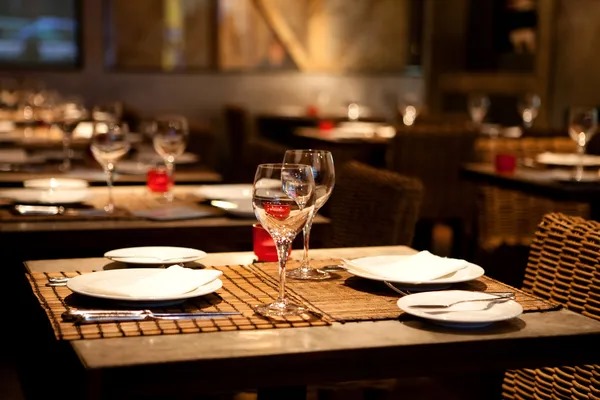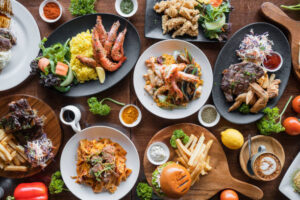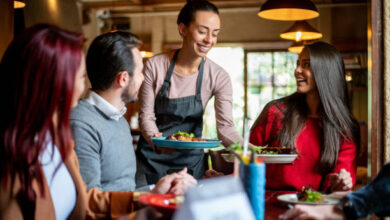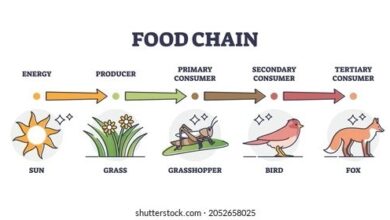Food Places Spice Up Your Life

If you’re looking to start the food place of your dreams, it’s an essential question to consider at the beginning: What type of food place? The kind of food locations you would like to begin will affect your concept, your branding, and your universal approach to business. The following article will outline the various types of establishments so that you can choose the one that best fits your goals for business.
What Is a Full-Service Food Place?

To categorize the categories of food places in this manner, there are three types of service: fast service, full-service, and casual fast. Full-service food places (FSRs) offer customers table providers and have a team of servers who take orders and supply meals. Restaurants that provide short-provider (QSR) services provide counter-provider or force-via services with pressure-through providers most effectively. Fast casual food places are situated between quick and full service. In recent years, the distinction between fast casuals, quick service restaurants, and fast casuals has become fuzzy. The spread of the pandemic as well as the shortage of staff have altered how many eateries approach their services. Delivery-only, mobile-order-and-pay and robot servers are some of the techniques being employed by restaurants that were previously full-service. While you are reading about typical restaurant models, be aware that how you handle and serve is entirely dependent on you. There are exclusive varieties of food places, starting from family-run restaurants to high-end connoisseur institutions. We’ll look at 12 of the most well-known sorts of food places and then discuss what is unique about them. Fast food eateries are among the first quick-service restaurants. Within the business, they tend to be called QSRs. One of the main characteristics of fast-food companies is that their menu is prepared quickly, typically in just a few minutes. The majority of the ingredients are cooked or frozen and need only to be warmed up. The food is served in disposable and takeout containers. The mass-produced style of food is referred to as “fast food.”.
Why open a fast food place?

Fast food establishments offer the best profitability margins of every type of food placed in our top 10 list. It is possible to avoid expenses such as flatware and tableware that are associated with dining in full-service restaurants. Fast food kitchens depend on a few pieces of equipment that include microwaves, deep fryers, and grills with flat tops, which means it is possible to avoid expensive repairs and equipment. Additionally, a lot of fast-food establishments are franchises or chains that allow you to profit from the existing brand’s power while avoiding the expense of advertising. These are the most common traits of fast-food restaurants:
- Service Type: Counter service or drive-thru services
- Menu A limited menu such as sandwiches, burgers, soft drinks and fries
- Interior: casual, practical dining areas that are easy to keep clean
- Examples: Burger King, McDonald’s, Taco Bell
- Price $
Casual restaurants offer full-service food places where customers are taken to their tables and served by servers. However, unlike formal dining establishments, informal restaurants offer spacious chairs, comfortable seating, and an informal ambiance. Menus include comfort foods as well as things that have proven authentic. It is not possible to find innovative cuisine or trendy décor in a casual eatery. Mom-and-pops, diners, and a lot of popular chain restaurants are regarded as relaxed dining places. Restaurants that serve casual dining account for more than 30% of the US portion of the market, which makes them among the most well-known types of restaurants. The menus are reasonably priced, and special offers like Happy Hour deals and coupon promotions are routine. Accessibility and affordability make informal eateries attractive to families with children. There’s a good chance of seeing tables changing fast at an informal restaurant. This can lead to higher profits. These characteristics can be expected at a casual dining establishment:
- Service Style: Full service
- Menu Menu items from the classic menu, such as comfort food and huge portions
- Interior: neutral decor, comfortable booth seating
- Examples: Olive Garden, Red Lobster, and Applebee’s
- Price $$
Fast-casual food places offer the fast service offered by a fast-food establishment with a broader selection of healthy, more natural food choices. The build-your-own menu is a popular fast-casual idea, offering sandwiches, wraps, or burritos that are made according to your orders. Payment, ordering, and food delivery are done at the counter. The self-service coffee and beverage stations are typical. Fast casuals can provide only table service, delivering orders, but with a service staff that is not available.
Why open a food place?
There’s an increasing number of fast-casual eateries that cater to customers looking for an easy snack that’s better than fast food and cheaper than sit-down casual eateries. These kinds of establishments have a high volume; however, they have fewer employees as compared to a restaurant that is full service. This money saved on the cost of labor can be utilized for items like menu ingredients, advertising, or maintenance of the building. Fast-casual restaurants are also able to provide guests with a mix of food options that are on and off the premises. Fast-casual food places typically include the following features:
- Service Style: counter service or restricted table service
- Menu Subs, sandwiches salads, wraps, or burritos
- Interior: modern but informal
- Examples: Panera Bread, Chipotle, Sweetgreen
- Price $-$$
Contemporary casual restaurants provide tables for dining at a table, similar to a typical restaurant However, they are outfitted with the look of upscale restaurants, with a modern menu as well as stunning interiors. A lot of contemporary eateries offer global or fusion food as well as vegan and gluten-free choices and environmentally friendly techniques. The upscale casual eateries are privately owned or are part of a smaller chain in a regional area. If you are a young person, modern casual restaurants are typically a great option when going out for dinner. If you’re looking for a fashionable hotspot that is affordable for numerous diners, an upscale casual eatery is an ideal choice to consider. They offer a classy appearance and an excellent menu, which is less expensive than fine food places. The style of restaurants allows the diner to experiment with the latest trends in food and sample diverse cuisines. Additionally, it also allows you to show your creative side through the tables and decor of your restaurant. It’s not a good idea to employ expensive, mismatched dishes in casual restaurants However, it’s acceptable to be modern in an environment with diners taking pictures across the table.
- Service Style table service mobile order-and-pay service, QR codes menus
- Menu: trendy cuisine, farm-to-table, global flavours, diet-inclusive options
- Interior A thoughtful, lively interior design that pops when you take a picture
- Examples: Seasons 52, Earls Kitchen + Bar, Iron Hill Brewery
- Price $$-$$$
The finest food place Establishments such as Michelin-starred eateries have the highest place when it comes to price and formality. The manner of dining in high-end dining is a tradition of the past with various rules and variations. There are a few extra details that aren’t found in other types of establishments, such as when servers “crumbs” at the table to clean any food particles from the tablecloth. The guests must be dressed appropriately when dining at a high-end restaurant. It gives dining at fine restaurants the feel of a private dining experience and makes it a special treat that is reserved for special occasions, for example, an anniversary, the birthday of a loved one, or the occasion of a wedding. The menus for fine dining include items that aren’t something you would eat every day, such as caviar, steak tartare, or foie gras. Cafes and coffee shops hold their spot in the hearts of a lot of consumers. They’re usually associated with certain routines, such as buying the morning cup of coffee while driving to work and catching up with friends to talk while waiting for the arrival of a loved seasonal beverage. Many cafes have co-working areas as well, which means those who are not in the office can drink the coffee they love as they work on laptops. Coffee shops and cafes offer an extensive menu of drinks that is focused on tea and coffee; however, they might also feature an assortment of bakery items and serve a smaller, simpler breakfast as well as lunch options.
Why open a coffee shop?

The expense of creating a tiny cafe is much less expensive than that of a restaurant with full service, which means you do not need to have a staff of many. Demand for coffee with a special flavour continues to increase, and the price of the coffee market is quite high. Specialty drinks like coffee or blended drinks could be priced as high as 80%, which means you’ll earn a substantial profit. Cafés and coffee shops possess boutiques that specialize in drinks like bubbly tea, smoothies, or even fresh juices, which are becoming increasingly popular and widely available. The market for beverages is expanding, and coffee and tea aren’t just the drinks that get the spotlight anymore. Smoothies and bubble tea stores offer a variety of customisable drink options, with numerous varieties, toppings, and additional ingredients to pick from. The majority of these food places are located in smaller spaces with limited seating. Customers order their food at the counter. Drinks are served using special drink equipment. Like tea and coffee at the same time, the markups on special drinks can be very expensive. It is expensive to invest in opening a juice shop or smoothie bar, which is much lower than for a full-service restaurant. There are franchise opportunities that let you profit from an established business model. The following category of restaurant we’ve included in our listing is an all-you-can-eat buffet. Buffet restaurants operate differently from other restaurants. There is no menu available; they are distinguished by self-serve buffets, meaning customers can eat however many times they want for a fixed cost. Instead of cooking meals on the spot, buffet cooks create large portions of meals that can be served in buffets or hot food stands. As a result, it is not possible to find delicate food items in buffets. You will, however, discover a wide selection of food items that can fill people up fast. As buffets offer plenty of food and places to eat, it’s difficult to comprehend how they make profits. The truth is that buffets are operating on a tiny margin. This means that much of every sale is used to cover the food costs. When you are planning to open a buffet, managing your food costs will be an issue. However, these kinds of establishments compensate for the higher costs of food ingredients in different ways. Buffet restaurants operate with only a small number of employees; generally, only two cooks are responsible for the preparation of meals. Buffets also rely on quantity to earn money. Some restaurants allow hundreds of patrons. Each day, sales increase because foot traffic is that high.
Food Trucks
Food trucks began as a fashion; however, they’ve evolved into an integral part of the food service industry. What’s not to like about mobile eateries, which can serve food items that are popular in food places, occasions, parks, or even homes? Food trucks are kitchens with wheels. They serve a limited menu, which usually concentrates on one kind of cuisine; however, they manage this perfectly. Customers can order their food and pay at the counter and then collect their food once it’s cooked. Fast food truck operators may employ orders and payments made via mobile or online to make their services more efficient. If you’re eager to begin your career in food service there are plenty of advantages to creating your truck for food. Smaller kitchens, smaller equipment, and the absence of workers make food trucks a more affordable investment than many different types of eateries. Food trucks also provide a means to try out your idea and menu before opening the doors to a full-service restaurant. Sometimes, they are left off the menu of types of food places concession stands, and snack bars that make for profitable food service establishments. The typical concession stand takes up a small area and is small enough to accommodate the counter for service, a few small pieces of equipment and, occasionally an unassuming kitchen. Certain concessions are made up of mobile kiosks or carts that are run by a single individual serving customers as well as preparing orders. There are concession stands in the ballparks, theatres, and amusement parks. Festivals, boardwalks, as well as outdoor festivals are ideal locations to sell concessions. The price of the creation of concession stands is less than that of a food truck. An investment of just a few dollars and a cost-effective concession make a great first venture or a side business. It is possible to start by utilising a table that folds along with a few pieces that comprise the concession apparatus. Machines for popcorn, snow cone machines, and hot dog rollers can be affordable and allow the owner to earn money from the most popular snacks. Pop-up eateries Bars, restaurants, and stands are an emerging way of doing business that permits proprietors, chefs, and guests to test different concepts in food and dining. Pop-up businesses are temporary spaces that serve food for a brief time and test a menu. A few pop-ups still follow the same procedure to “pop up” for events or even on a regular monthly basis. Other pop-ups develop into businesses of a larger size, including bars, food trucks, or even sit-down eateries. A pop-up store is similar to taking a dip in the sea of food service. The concept doesn’t need the same commitment as a brick-and-mortar establishment, but it lets users experiment with the concept and see how it performs. If you’ve not run any kind of restaurant previously, pop-ups are an excellent way to test whether you’ve got the necessary skills. Then, you can iron through the wrinkles using an open-air event, and when the numbers are increasing and you’re looking to move your restaurant to the next step and grow, you could become an entirely different kind of restaurant. Ghost restaurants are also known as virtual brands or ghost kitchens. A ghost restaurant, or a virtual or ghost kitchen brand, is an establishment with no physical location. In essence, a ghost restaurant has an open kitchen. The sales process is done online, and food orders are generally shipped. No interaction with guests is permitted within the premises. The kind of food places you would like to begin with will affect your concept, your branding, and your universal approach to business. Each brand is likely to have its menu and identity however, inside the kitchen of the ghost the food items are made together. Pete’s Pizza and Tina’s Tacos seem to be two distinct establishments with separate websites, but menus for both are cooked at the same time in the satellite kitchen. If you compare the costs of opening a kitchen that is ghostly against a full-service model restaurant, you’ll reduce costs in various aspects. The absence of a storefront implies that the space requirements for your restaurant are less, and the cost of rent and utilities will reflect this. There will be no front-of-house personnel and no furniture for the dining area or outdoor signage. But you’ll require investment in the digital aspect of your business through your website, social platforms, and third-party delivery companies. Delivery services are expected to increase, making the ghost kitchen an ideal business idea for the right businessman. The following characteristics in common characterize ghost kitchens: As the food service industry continues to grow, innovative solutions to food service challenges are producing new business concepts. There are more types of food places than ever before, and there are a variety of opportunities for those who want to break into the industry. Start small with a concession stand, food truck, or pop-up food place, and grow your business into something large over time.



